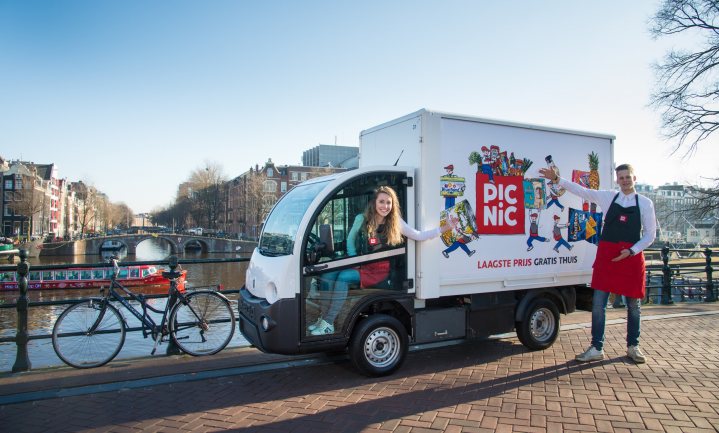
Picnic is a Dutch online retailer which started its operations in 2015. Picnic is unique in the Dutch retail market since it doesn’t own any physical stores. Picnic operates on your smartphone via its app, it is known for delivering its products to consumers via a small electronic trolley. Thanks to its data-driven business model Picnic is able to deliver its products fast, at a low price and moreover; free of delivery costs (Staalduine, 2016)
In 2017 Picnic tripled their revenue to €100 million, and for 2018 they expect to earn €300 million and so tripling their revenue for the second time in a row (Distrifood, 2018). This enormous expansion doesn’t go by unnoticed by their competitors. The Dutch retail market is dominated by Picnic’s two main competitors: Albert Heijn and Jumbo, together they account for 52% of the market (Vermijs, 2017). Both competitors launched a groceries home delivery service of their own, utilizing all their scale advantages to battle Picnic’s rise. For now, they seem to succeed, Jumbo has an online revenue of €140 million and Albert Heijn €400 million (this includes the online revenue of their sister companies Etos and Gall & Gall).
Looking at Europe’s leader and pioneer in home-delivered groceries the United Kingdom, the future looks bright for Picnic. In the UK 5% of the total groceries purchases are home delivered, in the Netherlands this is still only 1,6% so there is still a lot of room to grow (Staalduine, 2016). And growing is exactly what Picnic will keep on doing, at the moment it’s growing even faster than its supply chain can keep up with, in Utrecht for example they have a waiting list of over 1.500 people. Moreover, Picnic is all about thinking big, they recently announced their first international expansion towards Germany, starting operations in the Ruhr valley coming year. Picnic has proven to offer a unique value for its customers, and therefore I believe we will be seeing a lot more of it in the coming years
References:
Garstenveld P. (2017, 21 september). AH Online naar €400 miljoen omzet. Geraadpleegd op 17 september 2018, van https://privacy.vakmedianet.nl/distrifood/?ref=https://www.distrifood.nl/branche-bedrijf/nieuws/2017/09/ah-en-jumbo-in-top-20-twinkle-100-2-101112000
Garstenveld, P. (2018, 4 januari). Muller: ‘Picnic in 2018 naar €300 miljoen’. Geraadpleegd op 17 september 2018, van https://www.distrifood.nl/formules/nieuws/2018/01/muller-picnic-2018-naar-e300-miljoen-101114824?vakmedianet-approve-cookies=1
RetailNews. (2012, 24 januari). ‘Forse veranderingen in retaillandschap’. Geraadpleegd op 17 september 2018, van https://retailtrends.nl/news/28537/forse-veranderingen-in-retaillandschap+
Staalduine, J. O. S. E. P. H. I. N. E. (2016, 30 augustus). Een hoog wagentje als handelsmerk. NRC. Geraadpleegd van https://www.nrc.nl/nieuws/2016/08/30/een-hoog-wagentje-als-handelsmerk-4060425-a1518656
Vermijs, R. (2018, 1 mei). Investigating Dutch grocery trends over the past decade. Geraadpleegd op 17 september 2018, van https://blog.picnic.nl/investigating-dutch-grocery-trends-over-the-past-decade-1d2c63dc3ab9?gi=5151d13590b0


